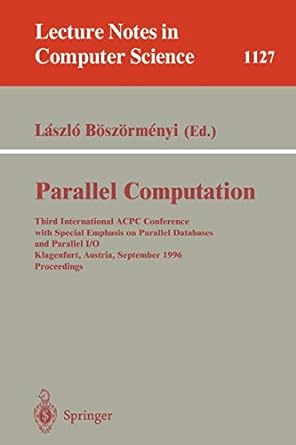Question
This question investigates using graph searching to design video presentations. Suppose there exists a database of video segments, together with their length in seconds and
This question investigates using graph searching to design video presentations. Suppose there exists a database of video segments, together with their length in seconds and the topics covered, set up as follows:
| Segment | Length | Topics covered |
| seg0 | 10 | [welcome] |
| seg1 | 30 | [skiing, views] |
| seg2 | 50 | [welcome, artificial_intelligence, robots] |
| seg3 | 40 | [graphics, dragons] |
| seg4 | 50 | [skiing, robots] |
Suppose we represent a node as a pair:
To_Cover,Segs,
where Segs is a list of segments that must be in the presentation, and To_Cover is a list of topics that also must be covered. Assume that none of the segments in Segs cover any of the topics in To_Cover.
The neighbors of a node are obtained by first selecting a topic from To_Cover. There is a neighbor for each segment that covers the selected topic. [Part of this exercise is to think about the exact structure of these neighbors.]
For example, given the aforementioned database of segments, the neighbors of the node [welcome,robots],[], assuming that welcome was selected, are [], [seg2] and [robots], [seg0].
Thus, each arc adds exactly one segment but can cover one or more topics. Suppose that the cost of the arc is equal to the time of the segment added.
The goal is to design a presentation that covers all of the topics in MustCover. The starting node is MustCover,[], and the goal nodes are of the form [],Presentation. The cost of the path from a start node to a goal node is the time of the presentation. Thus, an optimal presentation is a shortest presentation that covers all of the topics in MustCover.
(a.) Suppose that the goal is to cover the topics [welcome,skiing,robots]. Suppose the algorithm always select the leftmost topic to find the neighbors for each node. Draw the search space expanded for a lowest-cost-first search until the first solution is found. This should show all nodes expanded, which node is a goal node, and the frontier when the goal was found. Please indicate the order of node expansion in the search tree.
(b.) Give a non-trivial heuristic function h that is an underestimate of the real cost. [Note that h(n)=0 for all n is the trivial heuristic function.] Does it satisfy the monotone restriction for a heuristic function?
Step by Step Solution
There are 3 Steps involved in it
Step: 1

Get Instant Access to Expert-Tailored Solutions
See step-by-step solutions with expert insights and AI powered tools for academic success
Step: 2

Step: 3

Ace Your Homework with AI
Get the answers you need in no time with our AI-driven, step-by-step assistance
Get Started


